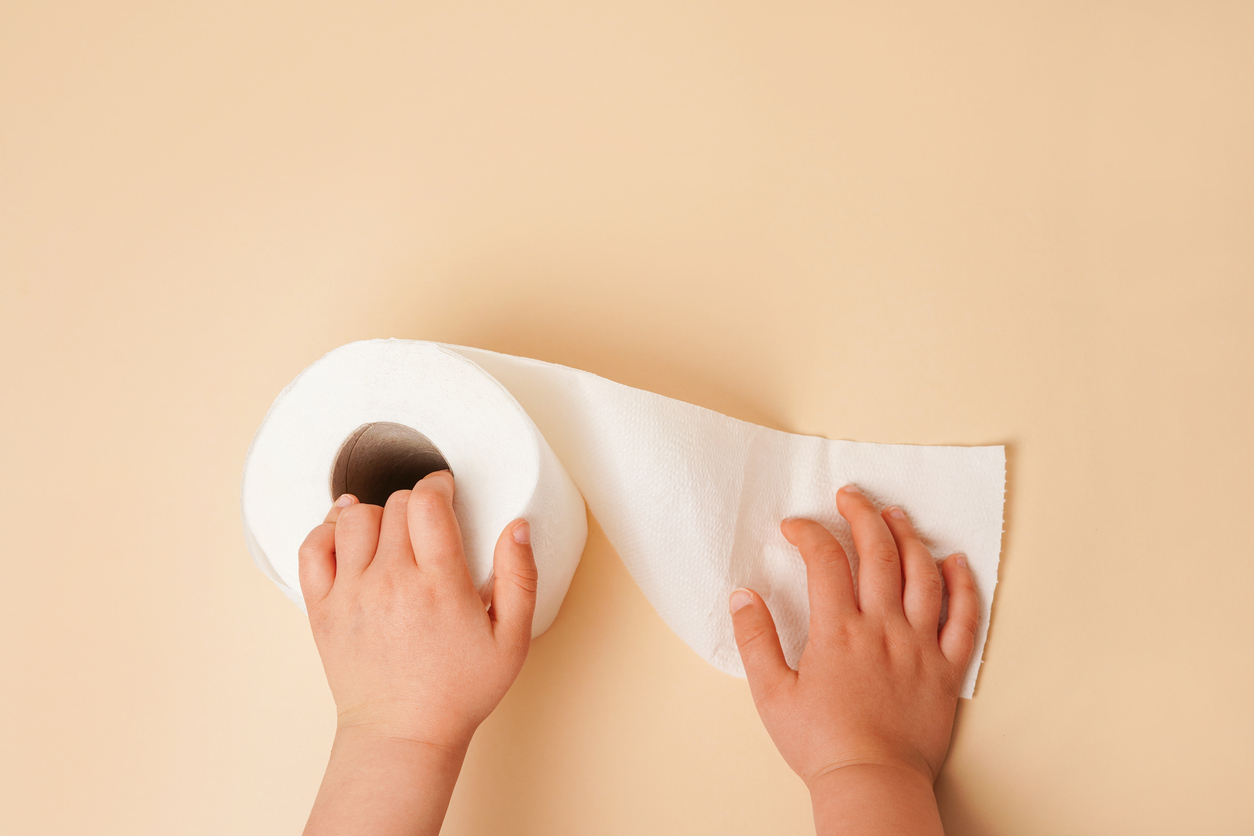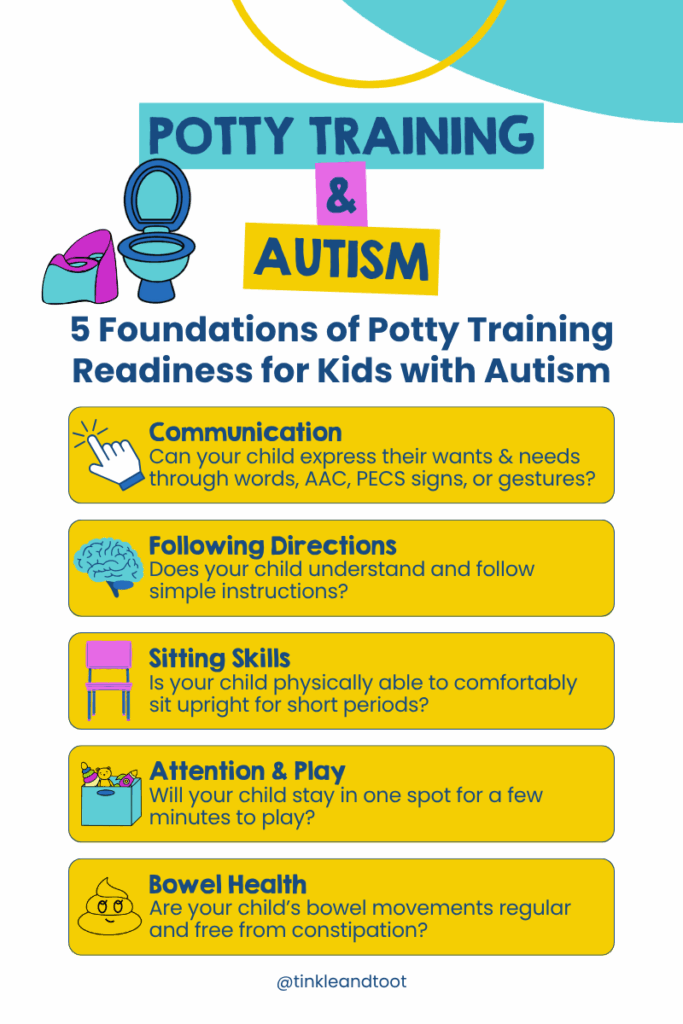
What Parents Need to Know & What to Ask Your ABA Provider
We are pleased to provide this guest article authored by Sarah Mechling, M.A., BCBA. Sarah is a well known, highly respected potty training expert for children on the spectrum and a valued partner of Wellspring Learning Centers. She is the founder of Tinkle & Toot, a resource hub for busy families seeking practical, science-backed potty training solutions & support. Sarah works with our professionals to ensure that we are providing the best potty training practices at our Nashville ABA centers.
Potty training is a big milestone! For any child, it works best when approached with a plan that’s tailored to their unique needs. For a child with autism spectrum disorder (ASD), it can be especially helpful to take into account their communication style, skills & strengths, and sensory preferences to create a supportive, step-by-step approach. Potty training success is absolutely within reach with the right strategies and a compassionate, individualized plan.
As a Board Certified Behavior Analyst (BCBA) and potty training coach, I’ve supported families for nearly 15 years – and I’ve also been through it myself as a parent. I’ve seen that meaningful progress is possible when we focus on the right supports, move at the child’s pace, and use consistent, effective strategies that honor the needs of both the child and the family.
Signs of Potty Training Readiness
One of the most common questions I hear is: “How do I know if my child is ready?”
While many resources talk about typical readiness signs, like showing interest in the potty, it’s actually more important to focus on foundational skills that set your child up for long-term success. Here are the key things I recommend looking for:
- Does your child have a reliable form of communication to express needs?
This might look like using one-word phrases, signs, AAC, PECS, or gestures. Vocal speech isn’t required! - Can your child follow simple directions?
Not that they always do (hah), but do they understand instructions like “First sit down, then I’ll give you the iPad”? - Is your child able to comfortably sit upright?
This is important for achieving an optimal potty posture. - Will your child stay in one spot to play for a few minutes?
Being able to engage in an activity in one area can help when learning to sit briefly on the potty.
A few other things to keep in mind:
- Does your child have consistent, healthy bowel movements?
Constipation can make potty training much harder and is often overlooked. - Are there challenging behaviors currently impacting daily routines?
These may need to be addressed first to avoid interfering with your child’s toileting success.
Working on these skills with your trusted ABA provider can create a solid foundation and help your child make quicker progress toward potty success. And don’t forget to check in with yourself, too – it’s just as important to feel ready and supported as a parent. If you’re not sure where to start, my Potty Training Readiness Checklist is a helpful resource.

Debunking the “3-Day” Myth
You’ve probably heard of the “3-day potty training method” and while it can be helpful to block off a few focused days to jumpstart the process, it’s important to know that true potty learning doesn’t begin and end in just three days.
The reality? Most children, including those with unique learning styles or support needs, benefit from ongoing support. A focused start can be great if it works for your family, but it’s not the only way to begin, and it’s just that: the beginning.
What matters more than speed is having a plan that makes sense for your child’s needs and your family’s routine. When you move forward with consistency, realistic expectations, and effective strategies, you’re setting the stage for lasting success without the pressure of a three-day finish line.
What to Look for in an ABA Provider for Toilet Training
If you’re considering ABA therapy and want support with toilet training, here are a few key things to look for:
✅ Collaborative planning. The best potty training plans are designed to be successful at home, not just during ABA therapy sessions. A strong provider will work with you to develop a realistic, sustainable plan.
✅ Focus on independence, not just compliance. Look for providers who go beyond time-based potty sits and instead teach children how to recognize their body’s signals, communicate when they need to go, and get to the toilet in time. Building interoceptive awareness and true initiation skills is key to long-term success.
✅ Use of appropriate reinforcement. ABA teams should focus on what motivates your child and use those interests to shape positive potty habits.
✅ Compassionate care. Above all, your provider should honor your child’s needs and your family’s values. A respectful, step-by-step process is far more effective than pressure-based approaches.
Recently, I had the opportunity to provide potty training training to the clinical team at Wellspring Learning Centers. The training focused on the Tinkle & Toot approach, which blends evidence-based practices rooted in the science of Applied Behavior Analysis (ABA) with a deep emphasis on compassion, caregiver collaboration, and real-world practicality.
Wellspring’s BCBAs are now equipped with this flexible framework, which allows them to support families in developing customized toilet training plans that work both in therapy and at home. Their team’s dedication to client-centered, respectful intervention makes them a trusted option for families seeking meaningful support in this area.
Preparing to Start Potty Training
Potty training success begins before the first trip to the toilet. Whether you’re working with a provider or figuring things out on your own, preparation matters.
Instead of jumping right in, start with:
✔️ Positive exposure to the potty. Read potty books, watch short videos with fun potty songs, and model the process with a favorite toy. These playful introductions help your child build familiarity without pressure.
✔️ Involve your child in the bathroom routine. Do diaper changes in the bathroom when you can. Let your child flush, unroll toilet paper, close the toilet lid, etc. These small moments build comfort and curiosity.
✔️ Try no-pressure potty sits. Give your child opportunities to sit on the potty (even with clothes on) for short periods – even if that means starting with a quick 1-second sit and building up to a minute or two. Keep it fun & reinforce these practice potty sits!
✔️ Work on foundational skills. Keep practicing communication, following simple directions, and being able to sit and play in one spot briefly; these are essential skills for potty training readiness.
✔️ Go with a plan that feels right. You don’t have to dive in just because someone else says it’s time. Take a thoughtful approach that fits your child’s needs. Of course, lean on support if you’re unsure when & how to begin.
If you’re looking for a step-by-step way to prepare, the Potty Prep Playbook is a great place to start.
Supporting Your Child with Autism Through Potty Training
Potty training doesn’t have to feel overwhelming, and you don’t have to figure it out alone. It’s okay to feel unsure; what matters most is finding an approach that truly fits your child and staying consistent with the support and strategies that feel right. Progress may take time, but with patience, the right tools, and a plan that centers your child’s needs, meaningful success is possible.
You’ve got this!
About the Author
Sarah Mechling, M.A., BCBA, is a Board Certified Behavior Analyst, potty training coach, and mom of four with over 15 years of experience supporting families, including those with children on the autism spectrum and other developmental differences. She earned her master’s in Applied Behavior Analysis from the University of South Florida and her undergraduate degree from the University of Florida, where she gained clinical and research experience in ABA.
As both a provider and parent, Sarah blends compassion with evidence-based strategies, helping families understand why certain approaches work and how to make them fit their unique needs. She’s the creator of the Potty Training Power Hour Course and founder of Tinkle & Toot, a resource hub for busy families seeking practical, science-backed potty training solutions & support.
You can get your child potty training and you’re not alone on this journey. Learn more at TinkleandToot.com or follow on Instagram @tinkleandtoot.